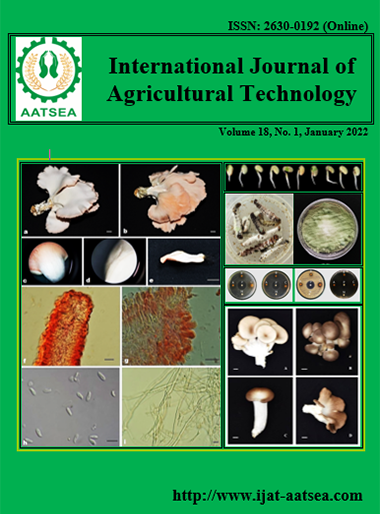Growth and survival of lactic acid bacteria during the fermentation of durian yogurt
Main Article Content
Abstract
The behaviors of lactic acid bacteria, Lactobacillus bulgaricus and Streptococcus thermophillus, during the fermentation of durian yogurt was investigated. Ripened pulp of durain was found to support the growth of the both of L.bulgaricus and S. thermophillus. The pH values ranged between 4.58-4.68, TSS 24.0-26.0%, and acidity (as lactic) 0.95-1.21% in yogurt after 24 hr of fermentation. The viable populations of lactic acid bacteria increased rapidly in the fermented yogurt after 4 hr to 12 hr fermentation with numbers averaged 1.22x107 cfu/g L.bulgaricus and 1.85x107 cfu/g S. thermophillus, their population stabilized after 12 hr to 24 hr of fermentation with numbers averaged 1.80x107 cfu/g L.bulgaricus and 1.12x107 cfu/g S. thermophillus after 24 hr of fermentation. The optimum time between 10-12 hr had the optimum characteristics of yogurt with pH 4.61-4.73, TSS 26.5%, lactic acid 0.92-1.10% and lactic bacteria count of 1.20-1.50x107cfu/g.
Article Details

This work is licensed under a Creative Commons Attribution-NonCommercial-NoDerivatives 4.0 International License.
References
Ahmad, A., Yap, W. B., Kofli, N. T. and Ghazali, A. R. (2018). Probiotic potentials of Lactobacillus plantarum isolated from fermented durian (Tempoyak), a Malaysian traditional condiment. Food Science and Nutrition, 6:1370-1377.
AOAC (1984). Official Methods of Analysis. 14th ed. The Association of Official Analytical Chemists, Virginia.
Dave, R. I. and Shah, N. P. (1998). Ingredient supplementation effects on viability of probiotic bacteria in yogurt. Journal of Dairy Science, 81:2804-2816.
Farnwort, E. R., Mainvilla, I., Desjardins, M. P., Gardner, N., Fliss, I. and Champagne, C. (2007). Growth of probiotic bacteria and bifidobacteria in a soy yogurt formation. International Journal of Food Microbiology, 116:174-181.
Hokputsa, S., Gerddit, W., Pongsamart, S., Inngjerdingen, K., Heinze, T., Koschella, A., Harding, S. E. and Paulsen, B. S. (2004). Water-soluble polysaccharides with pharmaceutical importance from durian rinds (Durio-zibethinus Murr.) : isolation, fractionation, characterization and bioactivity. Carbohydrate Polymers, 56:471-481.
Husin, N. A., Rahman, S., Karunakaran, R. and Bhore, S. J. (2018). A review on the nutritional, medicinal, molecular and genome attributes of Durian (Durio zibethinus L.), the King of fruits in Malaysia. Bioinformation, 14:265-270.
Khalil, E. S., Manap, M. Y. A., Mustafa, S., Alhelli, A. M. and Shokryazdan, P. (2018). Probiotic properties of exopolysaccharide-producing lactobacillus strains isolated from tempoyak. Molecules, 23:398.
Kramer, S. R. (2010). Benefits of durian. Retrieved from http://www.healthy-communications. com/durianbenefits.htm
Malaka, R., Maruddin, F., Dwyana, Z. and Vargas, M. V. (2020). Assessment of exopolysaccharide production by Lactobacillus delbrueckii subsp. bulgaricus ropy strain in different substrate media. Food Science & Nutrition, 8:1657-1664.
Murti, T. W., Bouillanne, C., Landon, M. and Desmazeaud, M. J. (1993). Bacterial growth and volatile compounds in yogurt-type products from soy-milk containing Bifidobacterium sub sp. Journal of Food Science, 58:153-157.
Ninlanon, W. (2007). Development of a yogurt-type from durian. The Proceeding of 6th Naresuan University Annual Conference, Agriculture Natural Resources and Environment, 119 p.
Tamime, A. Y. and Robinson, R. K. (2007). Yogurt science and technology. Science and Technology Woodhead Publishing Series in Food Science, Technology and Nutrition, pp. 608-645.
Terpou, A., Papadaki, A., Lappa, I. K., Kachrimanidou, V., Bosnea, L. A. and Kopsahelis, N. (2019). Probiotics in food systems: significance and emerging strategies towards improved viability and delivery of enhanced beneficial value. Nutrients, 11:1591.


